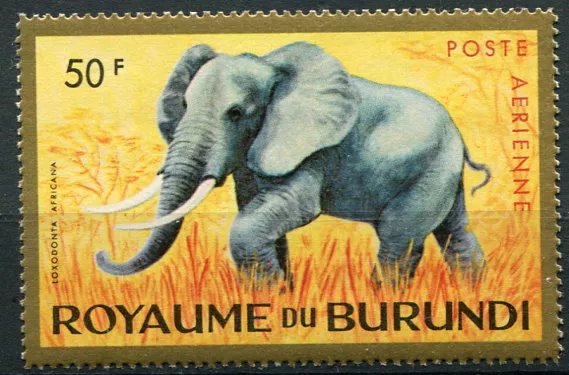- Home
- Philately: postage stamps
- Philately: stamps all over the world
- Africa
- Burundi
- (1964) MiNr. 108 A ** - Burundi - Air Stamp - African Elephant
(1964) MiNr. 108 A ** - Burundi - Aerial Stamp - African Elephant (Loxodonta africana)
Burundi - postage stamps.

| Code: | BUR-108A |
| Producer: | Burundi |
| Price: | 6,51 EUR |
| Availability: | Sold out - do not order! |
| Stock: | 0 Pcs |
| Denomination of the stamp: | 50 F |
| Year: | 1964 |
| Condition: | ** |
| Catalogue no. (MICHEL): | 108 A |
| Cat. number (St. Gibbons): | 98 |
| Cat. number (Yvert et Tellier): | PA 7 |
The African elephant (Loxodonta africana): the largest land mammal on the planet
The African elephant (Loxodonta africana) is the largest living land mammal on Earth. This species occurs naturally in sub-Saharan Africa, mainly in savannahs, dry forests, wetlands and some woodlands. It is known for its intelligence, strong social structure and the vital ecological role it plays in its natural environment.
Biological characteristics
African elephants can reach weights of up to 6-7 tonnes and a height at the withers of around 3 to 4 metres. They are easily recognizable by their large African-shaped ears, which are used for thermoregulation. The trunk, made up of a muscularly transformed upper lip and nose, is used for breathing, grasping food, communicating and sucking in water.
Unlike the Indian elephant, the African elephant has two finger-like projections at the end of the trunk. Both sexes have tusks - enlarged incisors that are made of dentin (ivory) and used for defence, obtaining food and manipulating objects.
Social Structure and Behavior
African elephants live in complex matriarchal communities. Groups are led by the oldest and most experienced female, called the matriarch. Female elephants and their young form stable units, while males usually leave the herd at maturity and live solitarily or in smaller groups.
Communication is through sounds, vibrations (infrasound) and touch. Elephants are able to recognize members of their herd even after long periods of separation, indicating a high degree of social intelligence.
Food and ecosystem roles
The African elephant is a herbivore and its daily food consumption can exceed 150 kg. It grazes grass, branches, tree bark and fruits. Due to its size and foraging patterns, it has a major impact on the landscape - helping to maintain the open nature of savannahs, dispersing seeds and creating watering holes to support biodiversity.
Conservation and threats
Although the African elephant is protected by international conventions (e.g. CITES), its populations continue to decline. The main threats are poaching for ivory, habitat loss and human-animal conflict. Elephants often migrate across large areas that tend to be disturbed by agriculture or infrastructure development.
International conservation organizations are working to protect remnant populations through reserves, community cooperation programs, and monitoring elephant movements using satellite technology.
Attractions
- African elephants have an exceptional memory and ability to learn.
- Chobot contains approximately 40,000 muscle bundles.
- A baby elephant is born after a gestation period of nearly two years and weighs approximately 100 kg.
Frequently Bought Together - (1964) MiNr. 108 A ** - Burundi - Aerial Stamp - African Elephant (Loxodonta africana)
From the Same Category - (1964) MiNr. 108 A ** - Burundi - Aerial Stamp - African Elephant (Loxodonta africana)
Burundi - postage stamps. Guereza guereza (Colobus guereza): the elegant acrobat of the African rainforest The mantled guereza is a magnificent primate native to Africa's tropical forests and savannahs. Its distinctive black and white coat and long ...
Burundi - postage stamps. Type I. - overprint BURUDI - does not overprint IMPALA Type II - overprint BURUDI - overlaps the inscription (IMP)ALA Impala (Aepyceros melampus) - Elegance of the African Savannah Impala, a slender antelope known for its ...
Czech Republic - postage stamps Zodiac Sign: Scorpio (October 23 - November 21) The sign of Scorpio is one of the most intense and mysterious signs of the zodiac. It falls under the rule of the planet Pluto, formerly also Mars, and is associated ...





